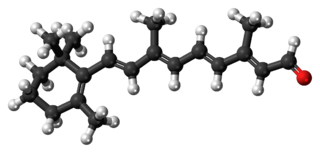Lecithin retinol acyltransferase is an enzyme that in humans is encoded by the LRAT gene. [5] [6]
Lecithin retinol acyltransferase is an enzyme that in humans is encoded by the LRAT gene. [5] [6]
Lecithin retinol acyltransferase is a microsomal enzyme that catalyzes the esterification of all-trans-retinol into all-trans-retinyl ester during phototransduction, an essential reaction for the retinoid cycle in visual system and vitamin A status in liver.
Mutations in this gene have been associated with early-onset severe retinal dystrophy. [6]
LRAT was overexpressed in colorectal cancer cells compared to normal colonic epithelium. Strong LRAT expression was associated with a poor prognosis in patients with colorectal cancer. [7]

Retinal is a polyene chromophore. Retinal, bound to proteins called opsins, is the chemical basis of visual phototransduction, the light-detection stage of visual perception (vision).

Lecithin–cholesterol acyltransferase is an enzyme, in many animals including humans, that converts free cholesterol into cholesteryl ester, which is then sequestered into the core of a lipoprotein particle, eventually making the newly synthesized HDL spherical and forcing the reaction to become unidirectional since the particles are removed from the surface. The enzyme is bound to high-density lipoproteins (HDLs) (alpha-LCAT) and LDLs (beta-LCAT) in the blood plasma. LCAT deficiency can cause impaired vision due to cholesterol corneal opacities, anemia, and kidney damage. It belongs to the family of phospholipid:diacylglycerol acyltransferases.

Acetyl-CoA acetyltransferase, mitochondrial, also known as acetoacetyl-CoA thiolase, is an enzyme that in humans is encoded by the ACAT1 gene.
Biotinylated retinoids are derivatives of retinol carrying a biotin group for use in the isolation and purification of Retinol Binding Proteins involved in the visual cycle. The first biotinylated retinoid was synthesized in 2002 and was used in the isolation and characterization of RPE65.
In enzymology, a retinol dehydrogenase (RDH) (EC 1.1.1.105) is an enzyme that catalyzes the chemical reaction

RPE-retinal G protein-coupled receptor also known as RGR-opsin is a protein that in humans is encoded by the RGR gene.

Retinal pigment epithelium-specific 65 kDa protein, also known as retinoid isomerohydrolase, is an enzyme of the vertebrate visual cycle that is encoded in humans by the RPE65 gene. RPE65 is expressed in the retinal pigment epithelium and is responsible for the conversion of all-trans-retinyl esters to 11-cis-retinol during phototransduction. 11-cis-retinol is then used in visual pigment regeneration in photoreceptor cells. RPE65 belongs to the carotenoid oxygenase family of enzymes.

Retinol binding protein 1, cellular, also known as RBP1, is a protein that in humans is encoded by the RBP1 gene.

11-cis retinol dehydrogenase is an enzyme that in humans is encoded by the RDH5 gene.

Glutathione S-transferase M3 (brain), also known as GSTM2, is an enzyme which in humans is encoded by the GSTM99

Retinol dehydrogenase 11 is an enzyme that in humans is encoded by the RDH11 gene.

Retinol-binding protein 2 (RBP2) is a protein that in humans is encoded by the RBP2 gene.

Glycerol-3-phosphate acyltransferase 1, mitochondrial is an enzyme that in humans is encoded by the GPAM gene.

Retinol dehydrogenase 12 is an enzyme that in humans is encoded by the RDH12 gene.

Glutathione S-transferase A3 is an enzyme that in humans is encoded by the GSTA3 gene.

D-beta-hydroxybutyrate dehydrogenase, mitochondrial is an enzyme that in humans is encoded by the BDH1 gene.

Retinol dehydrogenase 8 is an enzyme that in humans is encoded by the RDH8 gene.

2-acyl-sn-glycero-3-phosphocholines are a class of phospholipids that are intermediates in the metabolism of lipids. Because they result from the hydrolysis of an acyl group from the sn-1 position of phosphatidylcholine, they are also called 1-lysophosphatidylcholine. The synthesis of phosphatidylcholines with specific fatty acids occurs through the synthesis of 1-lysoPC. The formation of various other lipids generates 1-lysoPC as a by-product.
NADP-retinol dehydrogenase (EC 1.1.1.300, all-trans retinal reductase, all-trans-retinol dehydrogenase, NADP(H)-dependent retinol dehydrogenase/reductase, RDH11, RDH12, RDH13, RDH14, retinol dehydrogenase 12, retinol dehydrogenase 14, retinol dehydrogenase (NADP+), RalR1, PSDR1) is an enzyme with systematic name retinol:NADP+ oxidoreductase. This enzyme catalyses the following chemical reaction

Retinol dehydrogenase 13 (all-trans/9-cis) is a protein that in humans is encoded by the RDH13 gene. This gene encodes a mitochondrial short-chain dehydrogenase/reductase, which catalyzes the reduction and oxidation of retinoids. The encoded enzyme may function in retinoic acid production and may also protect the mitochondria against oxidative stress. Alternatively spliced transcript variants have been described.